
September 16 - November 29, 2015
Curated by Christine Shaw
Click here to download the micropublication featuring A Reading of Art in the Anthropocene, an artist project by Etienne Turpin in collaboration with Anna-Sophie Springer, Tomás Saraceno, Sasha Engelman, Jol Thoms, and the students of the Institut für Architekturbezogene Kunst (Braunschweig, Germany), an exhibition text by Christine Shaw, project statements, artist biographies, and full colour illustrations throughout.
Opening Reception
Wednesday, September 16, 5 – 8pm
A FREE shuttle bus will depart from Mercer Union (1286 Bloor Street W.) at 5:30pm and return for 8:30pm.
Artists will be in attendance.
Artist Talk: Kara Uzelman: The Cavorist Projects
Thursday, September 17, 12:30 – 1:30pm
Annie Smith Mezzanine, Sheridan College
1430 Trafalgar Road, Oakville
FREE, all welcome. Kara Uzelman will discuss The Cavorist Projects (2009-2015), a series of objects, contraptions, experiments and documents left over from a fictional community of people that believed in the existence of a mythical element, “cavorite”, known to possess anti-gravitational properties.
FREE Contemporary Art Bus Tour
Sunday, September 27, 12 – 5pm
The tour starts at Koffler Centre of the Arts at Artscape Youngplace (180 Shaw Street) at 12noon and then departs for Blackwood Gallery, Art Gallery of York University and Doris McCarthy Gallery. To RSVP, email the Doris McCarthy Gallery at dmg@utsc.utoronto.ca or call 416-287-7007 by Friday, September 25 at 5pm.
Dance Performance: Weather
Friday, October 30, 2-4pm
University of Toronto Mississauga
FREE, all welcome
Weather explores the current global ecological crisis and its embodied impact through site-specific choreography and sonic experiences that will engage with the natural landscape and built environment of the University of Toronto Mississauga’s campus. Each solo vignette plays with the idea of instability, of teetering on the brink of disaster. Spectator peregrination through the campus is required.
Choreographed by Brandy Leary (Anandam Dancetheatre), in collaboration with the performers Amy Hampton, Louis Laberge-Côté, Michael Caldwell, Ryan Lee. For more information, please click here.
Running with Concepts: The Geologic Edition
November 28 – 29, 10am-6pm
Blackwood Gallery
This two-day hybrid event is part colloquium, part workshop, part performance, and part experiment with 13 selected presentations led by five distinguished mentors including Kelly Jazvac (artist, Department of Visual Arts, Western University, London, ON) in collaboration with Patricia Corcoran (geologist, Department of Earth Sciences, Western University, London, ON), Sarah Anne Johnson (artist, Winnipeg), and Anna-Sophie Springer (curator, and Co-Director of K. Verlag Press, Berlin, DE & London, UK). Hosted by Christine Shaw (Director/Curator of the Blackwood Gallery). For more information on the conference, please click here. (Registration information and a complete list of presenters will be released in late October.)
A Reading: Art in the Anthropocene (part II)
Sunday, November 29, 2015, 5pm
A performance of poetic, distributed knowledge production will conclude Running with Concepts: The Geologic Edition. Etienne Turpin will lead participants in a disassembly, reading, and reassembly of the recently published Art in the Anthropocene for a poetic encounter with chance composition. John Paul Ricco (Associate Professor of Contemporary Art, Media Theory and Criticism, UTM) will read aloud the final composition.
For more information, please click here.
The pen moves across the earth: it no longer knows what will happen, and the hand that holds it has disappeared. (1)
The Earth is mute but she makes noise, and to attune ourselves to these atmospheric qualities means to sense out and give name to the movements of particles, cells, sand, aerosols, molecules, dust, ash, and pollen; the same with fluids, drops, currents, streams, drift, turbulence, evaporation, volatilization, thermodynamics, breath, and odour; likewise even for fire, flames, plasma, light, fields, forces, beams, energy, gravity, reflection, inference, magnetism, and transmissions. These particulars act and interact. Their morphological qualities—the forms they take on as they undergo relational movements of transference—settle into temporary states, only to resituate themselves.
This exhibition explores the means by which knowledge of the elemental forces and geopolitical processes impacting upon us in the 21st century can be generated in the presence and absence of evidence. Combining raw minerals and high-tech elements, each work in the exhibition makes visible the forces of composition and decomposition that are rumbling just below or flowing across the surface of the Earth. Whether the circulation of the winds and seawaters, or the cycling of substances through the spheres – oxygen, carbon, water, and nitrogen – or the emergence and decay of life, what is revealed is that matter matters. Matter and matters intertwine.
Michel Serres, in a way resounding Rachel Carson’s famous dictum that in every grain of sand is a story of Earth, writes in his Atlas: “Indeed, it is worth telling the (his)tory of a small, local, singular element, that of an atom, a grain of sand, a thin layer of fluid somewhere in the middle of this violent zone where various flows intermingle.” (2) The world is an atlas that we must constantly draw and redraw, knowing that our map is the territory. What is the texture of this map? The Anthropocene insists on the texture of the world as a fabric, as a flowing surface, an amorphous expanse of mud, whose differentiation is expressed by varying qualities, not in the form of clear-cut entities, artificial order, or cause-and-effect sequences. The world just is, and it is a mess.
As you erase me now, I will erase you tomorrow, wherever you may be. (3)
Introduced in recent years, the term Anthropocene is used to describe the current geological epoch in which our earth finds itself, defining the human being as the most important factor influencing the planet's biological, geological, and atmospheric processes. The Anthropocene exceeds the geological field; it is synonymous with a dizzying set of ethical, political, and scientific questions. It means a point of no return and a radical questioning of our representations of the world, including the boundary between nature and culture. As Etienne Turpin and Heather Davis declare in their introduction to Art in the Anthropocene, “the way we have come to understand the Anthropocene has frequently been framed through modes of the visual, that is through data visualization, satellite imagery, climate models, and other legacies of the ‘whole earth.’ Art provides a polyarchic site of experimentation for ‘living in a damaged world,’ as Anna Tsing has called it, and a non-moral form of address that offers a range of discursive, visual, and sensual strategies that are not confined by the regimes of scientific objectivity, political moralism, or psychological depression.”(4)
The works in this exhibition exemplify the diversity of highly dynamic changes characteristic of the Anthropocene: climate change, soil erosion, the “Great Acceleration,” resource extraction, urbanization, the digitalization of all areas of life, drastic species loss, the pressure of the sun… but they do so by harnessing the power of art, including a tendency toward metaphor and sensuous-aesthetic play, a resistance to received ideas, and a willingness to colonize new areas of knowledge. They persuade us to think differently about our relationship to the Earth. In the end, what this exhibition points to is the hand we have in moving the Earth.
We are disturbing the earth and making it quake. (5)
- Christine Shaw, Director/Curator of the Blackwood Gallery
1. Paul Auster, “White Nights,” in Disappearances, Selected Poems (New York: Overlook Press, 1988), 88.
2.
Michel Serres, The Natural Contract, trans. Elizabeth Arthur and William Paulson (Ann Arbor: The University of Michigan Press, 1995), 86.
3.
Jorge Luis Borges, “Ibn-Hakam al-Bokhari, Murdered in His Labyrinth” in Jorge Luis Borges: Collected Fictions, trans. Andrew Hurley (New York: Penguin Books, 1999), 258.
4.
Heather Davis and Etienne Turpin, “Art & Death: Lives Between the Fifth Assessment & The Sixth Extinction,” in Art in the Anthropocene: Encounters Among Aesthetics, Politics, Environments and Epistemologies (London: Open Humanities Press, 2015), 3.
5.
Michel Serres, The Natural Contract, 86.
Video interviews with artists Tim Knowles, Jennifer Rose Sciarrino, Kara Uzelman & Robert Wysocki on September 2015.
For a HD version, please click on the Vimeo link above.
Videographer: Michael Dopsa
Ligne
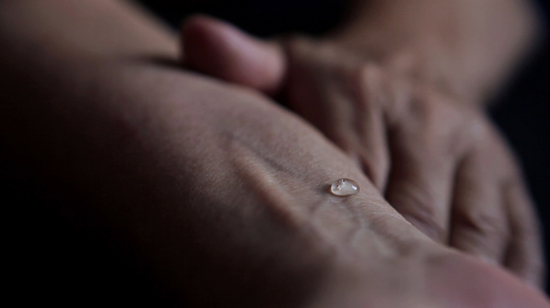
While the production of traces constitutes a revelatory act, Ismaïl Bahri equally privileges experiences that build on the organic and impermanent nature of things. The natural qualities of the ordinary world slip away in a slow perpetual movement, and remain elusive. The basic materials used in Bahri’s works are manipulated and ultimately transformed, often through mechanically inspired gestures and procedures that are related, in one way or another, to cinema or photography. A questioning of art’s permeability in regards to the contemporary world is generated through a quasi-cinematic process based on principles of recording, motion, and simultaneous creation on a sensitive surface and a projection screen.
Ligne accounts for a close observation of a body. But here, only water is used as an exploration tool. The water reacts to the pulse of blood. Due to its magnifying, shining and vibratory properties, the water bead acts as a medium sensitive to the lesser intensities running through the body. It stays on the surface but probes – by capillarity – a buried inwardness.
Nostalgie #1
La main du rêve
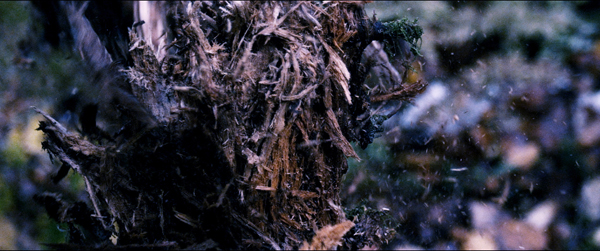
Pascal Grandmaison’s non-narrative films and videos offer poetic and critical meditations on the nature of representation. The experiments he carries out, on natural materials as much as on artificial ones, form a eulogy to decomposition, an ode to matter’s capacity to transform things, and the continual renewal of the cycle of living matter. A latent polarity manifests itself in the sweet tension of oppositional principles: light and dark, presence and absence, material and immaterial, force and fragility, reality and imaginary, distance and intimacy, gravity and weightlessness.
La main du rêve presents the slow journey of an invisible hand that activates nature in a surreal, reverse movement, as a constant oscillation between the deconstruction and reconstruction of organic matter. The video’s percussive soundtrack is made from a mathematical algorithm synthesizing the surface sounds of wood, metal, glass or rubber.

HD video, 10 mins.
Private Collection.
Image courtesy of the artist
.
For Nostalgie #1 Grandmaisonwas inspired by AlbertCamus’s account of Sisyphus, who, according to Greek myth was punished for all eternity to roll a rock up a mountain only to have it roll back down to the bottom after he reaches the top. Camus, in The Myth of Sisyphus, claims that he is the ideal absurd hero and that his punishment is representative of the human condition: Sisyphus must struggle perpetually and without hope of success. In Grandmaison’s video, the rock is tethered to a rope and pulled by an invisible force.
Painted Leaves
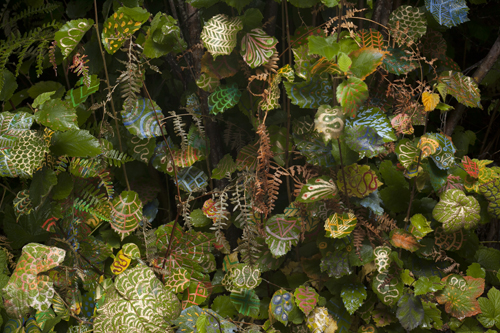
Sarah Anne Johnson’s Painted Leaves, commissioned by the Blackwood Gallery for the Bernie Miller Lightbox, presents a detail of a photographic landscape overlaid with myriad fine details, earthly colours, and mystical light. Oil paint has been hand applied to a chromogenic print of an understory of leaves in a temperate coniferous forest. The leaves are marked with decorative motifs in sunflower yellow, marine blue, flame orange, and brushed gold. Yet the image is an overture to humanity’s thoughtless imprint on the landscape.
The Anthropocene is an epoch where there are more trees growing in farms than in the wild, where more rock and soil is moved by bulldozers and mining than all ‘natural’ processes combined, and where the climate is tipping out of control due to the burning of oil, gas, and coal. Industrial capitalism is irreversibly altering the natural cycles of the biosphere; nature is now a product of culture. At the same time, carefully contrived patches of ‘nature’ lie open to the sky and to a multitude of uses and meanings in our urban landscapes. Flora is tamed and groomed into domestic symbols, civic showplaces, and national icons. In the age of the Anthropocene, many of us are sensing, as Ivan Illich called it, “the shadows our future throws.”These shadows are profoundly shifting our perceptions and yet many of our behaviours seem little changed. Johnson’s disturbance of the surface of the photographic image attempts to find the shape of hope in the shadows.
Ink on Paper Landscape
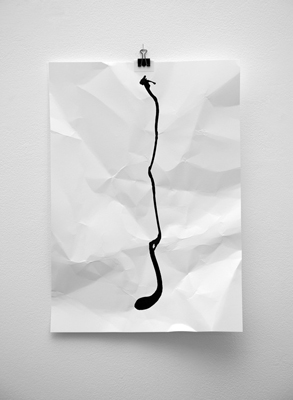
various dimensions.
Image courtesy of the artist.
Tim Knowles’s creative practice incorporates chance, process, and performance into mark-making systems. Art is approached as a generative process aligned with the games and experiments of Situationist and Fluxus artists. In his automatic drawings, formal elements are open to mechanisms or phenomena beyond the artist’s control–seeking to reveal the hidden, or otherwise unnoticed, motion of objects. These projects capture ephemeral traces: of footsteps in the forest; the full moon’s reflection on undulating water; or intricate movements of a parcel traveling through the postal system. Marked by a romantic take on conceptualism, he travels with torches through the night landscape or attaches drawing tools as freehand extensions to the tips of tree branches to create a record of their movement. In collaboration with the wind and local weather conditions, calligraphic gestures and readings are rendered on paper. Nature becomes an eco-agent of sorts in automatic drawing.
In a new drawing series commissioned by the Blackwood Gallery entitled Ink on Paper Landscape, Knowles makes visible the geomorphological forces that perpetually mark the surface of the earth. Here, folded crushed paper acts as a landscape for the sudden flow of ink. The creative act is seemingly simple: load one pipette with ink, squeeze, and release. But the process the ink visualizes is complex. It is pulled by gravity, picks up speed, slows down, undulates, and, at times, cleaves. Like a signature, each system reveals the characteristics of an otherwise unnoticed physical experience.
2015 - 06 - 21 - 2024 - 06 - 21, 2014
Ripple Affect
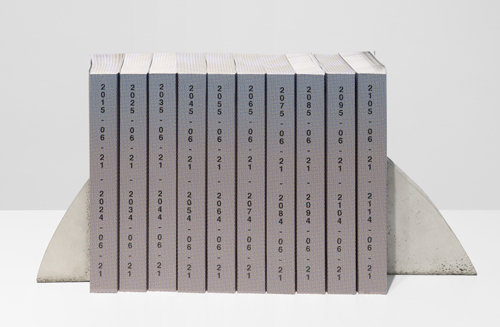
digital printing on paper
14” x 11” x 2”.
Image courtesy of Daniel Faria Gallery.
Through sculpture, installation, and video, Jennifer Rose Sciarrino examines the continually evolving line between real and 3D rendered surfaces in data visualization and contemporary object making. Her work has crystallized geology in resin, supported the oxidization of metal, and captured the irradiation of sunlight. 2015-06-21 – 2114-06-21 is a book work that charts the movement of the sun on the longest day of the year, June 21st, in Toronto, Canada, from the years 2015 to 2114. Images of the city’s sky are generated though 3D modeling software and converted to a colour halftone in CMYK. Each spread depicts a successive hour in the 24 hours of the day, rendering the passing of time tangible. Human experience has an inherently obsessive relationship with time; it feels multiple, accumulated, unceasing, and simultaneously unstable. As time progresses 2015-06-21 – 2114-06-21 will exist in the future, the present-future, past-present-future and will ultimately become a depiction only of the past.
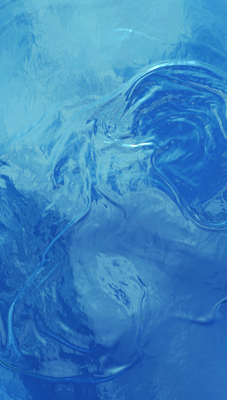
HD Video, 4 Minute Loop.
Image courtesy of the artist
Recently, Sciarrino’s focus has turned to haptic technology and its impact on current modes of production, including the development of metamaterials, advancements in fabrication, and the enhancement of virtual spaces. For Ripple Affect, Sciarrino used openFrameworks (an open source C++ toolkit for creative coding) and motion capture to record her gestures on a digital water surface IRL (“In Real Life”). The effect the hand has on the digital surface is an estimation based on physical and mathematical evidence of how the material (water) reacts to dynamics. Using this method, Sciarrino’s hand generates waves and ripples in a digitally replicated world, yet the hand itself has disappeared leaving only the effects caused by its touch on the digital surface. Ripple Affect provokes a speculative reflection on the visceral, enigmatic substance called water that is so essential to our survival.
Magnetic Stalactites

Image courtesy of Sommer & Kohl, Berlin DE.
Photo credit: Jens Ziehe.
Hinging on the speculative histories of objects, Kara Uzelman’s quasi-archaeological and anthropological assemblages use narrative, myth and tangential association to consider the immaterial qualities of the material world. Embodying a deliberate contradiction of material excess and material thrift, Uzelman’s configurations of gleaned objects and information could be undone and reassembled or returned to their prosaic origins at any moment, underscoring the temporality of objects, their fluctuating value as useful things, aesthetic objects, mnemonics, and narrative devices.
Uzelman’s The Cavorist Projects takes as its starting point eccentric scientist Joseph Cavor, a character from H.G. Wells’ 1901 novel The First Men on the Moon, who developed an anti-gravitational material he named ‘Cavorite’. Magnetic Stalactites (from The Cavorist Projects) are pendulous sculptures consisting of a collection of random metal detritus (tin cans, beer bottle caps, spoons, scissors, baking pans) that hang swarm-like from the gallery ceiling with great energy and leaps of the imagination. Magnetism emancipated from gravitational principles is harnessed as sculptural force; it shapes not only the narrative as a whole, but also, literally, the objects themselves.
traction

Lake Wales, Florida forty-four 22" industrial floor fans, 2000w scoop light.
Installation photo
of The Contemporary Art Museum at the University of South Florida & Flight 19 at the Tampa
Amtrak Station, Tampa, Florida.
Photo credit: Peter Foy.
Robert Wysocki’s "site-specific" installation suggests desert physiography: dunes, mesas, buttes, mushroom mounds, and other ‘deflations’ (the removal of material from beaches and other surfaces by wind action). In traction, Wysocki uses 17 industrial floor fans as nature’s surrogate to push 30,000 pounds of sand across the Blackwood Gallery floor into a crescent-shaped dune. The dune continuously recomposes itself, eroding on one side and building up on the other. Like Robert Smithson’s flow works, Wyoscki’s dune is “entropy made visible.”
The shear physical execution and perfect replication of a dune at first distracts, but then leads to a state of contemplation. We find ourselves involved in the minute granular relationships, the slip face, pointy peaks, and seductive patterns. We marvel at how the grains get along so well, how they move together, and how they miraculously find each other after being blown about. But then we wonder, how did the sand get here? Where did it come from? And here is where a critical relation to the nature of the sand itself emerges. traction points to how technology has made incursions on—and wholly transformed—the natural.
Pascal Grandmaison lives and works in Montreal. While he is best known for his work in photography and film and video, his oeuvre also includes sculpture and installation. Pascal Grandmaison is interested in the ways images influence our perception and understanding of infinity. His work has been featured in solo exhibitions at Musée d’art contemporain de Montréal, Casino Luxembourg – Forum d’art contemporain (Luxembourg), the Art Gallery of Hamilton (Ontario), Prefix Photo (Toronto), Galerie Éponyme (Bordeaux) and Galerie René Blouin (Montreal). He has also participated in group exhibitions, most notably at La Compagnie, lieu de creation (Marseilles), the Art Gallery of Hamilton (Ontario), Musée d’art contemporain de Montréal (Montréal), Centre culturel canadien (Paris). His videos have been presented internationally, more recently at Haus der Kulturen des Welt (Berlin), Palais de Tokyo (Paris), Edinburgh Art Festival (Edinburgh), Le Fresnoy (Tourcoing), and Centre Pompidou (Paris). He is represented by Galerie René Blouin (Montréal) and by Eponyme Galerie (Bordeaux).
Winnipeg-based artist Sarah Anne Johnson was trained as a photographer but uses a variety of media including painting, sculpture, and performance. She received a BFA from the University of Manitoba and completed an MFA at the Yale School of Art. Earlier this year Johnson debuted her first mid-career retrospective, Sarah Anne Johnson: Wonderland, 2002-2014, at The Contemporary Art Museum Raleigh and unveiled a 144 foot photographic mural at the Westin Harbour Castle Conference Centre commissioned by Scotiabank Contact Photography Festival. She has been collected by several significant institutions including The Guggenheim Museum, The National Gallery of Canada, New York Library, and The Phillips Collection. She has participated in group exhibitions at The Massachusetts Museum of Contemporary Art, The Canadian Biennial at the National Gallery of Canada, The Guggenheim Museum, The National Gallery of Victoria, and La Fondation Cartier in Paris. In 2008 Johnson was the recipient of the inaugural Aimia Prize for Contemporary Photography and is a finalist for the 2015 Sobey Art Award. She is represented by Stephen Bulger Gallery in Toronto and Julie Saul Gallery in New York.
Tim Knowles is an artist based in London, UK. His creative practice incorporates chance, process, and performance into mark making systems. Like a signature, each system reveals the characteristics of an otherwise unnoticed physical experience. Knowles has exhibited widely, including at MassART (Boston), Art Stations (Poznan), Generali Foundation (Vienna), Plymouth Arts Centre, Hayward Gallery (London), and Gallery Skuc (Ljubljana). His work has been featured in Art in America, Artforum, Cabinet Magazine, The Independent, The Guardian and Art and Ecology Now, published by Thames and Hudson. He holds awards and residencies from South West Arts, the British Council in Rome, the Henry Moore Foundation, and the Institute of Biological, Environmental, and Rural Studies in Aberystwyth, Wales. Knowles studied sculpture at the Bath College of Higher Education and has taught at numerous institutions throughout the UK and the USA including Stanford University, MIT, and Slade School of the Art. Knowles will be featured in Scotiabank Nuit Blanche on October 3, 2015 as part of the exhibition The Work of Wind, curated by Christine Shaw.
Jennifer Rose Sciarrino is a Toronto-based artist working in photography, sculpture, and installation. Her work actively examines the continually evolving line between real and 3D rendered surfaces in visualization and contemporary object making. Sciarrino has exhibited work nationally in a number of group and solo exhibitions including Patterned Recognition, a solo exhibition at Daniel Faria Gallery (Toronto 2014), NADA New York (with Daniel Faria Gallery, 2014), Who's Afraid of Purple, Orange and Green at Dunlop Art Gallery (Regina, 2014), From Nature at Equinox Gallery (Vancouver, 2013), x,y,z at Daniel Faria Gallery (Toronto, 2012), trans/FORM at The Museum of Contemporary Canadian Art (Toronto, 2012) and To What Does This Sweet Cold Earth Belong? at The Power Plant (Toronto, 2011). In 2013 Sciarrino was a recipient of the Toronto Friends of the Visual Arts “Artist Prize”.
Kara Uzelman‘s sculptural works are typified by a deep engagement with found objects and material processes in which collections of discarded objects, the newly obsolete, and remnant materials of everyday life are collaged with research salvaged from our collective dustbin. Since graduating with a BFA from Emily Carr University of Art and Design in 2004, Uzelman’s work has been exhibited internationally in DIY exhibitions, artist run centers, museums, commercial galleries, and art fairs. Recent exhibitions include Concerning Certain Events at the Mendel Art Gallery (Saskatoon, 2015), Gleaners at the Art Gallery of Nanaimo (2015), The Geometry of Knowing at Audain Gallery (Vancouver, 2015), and From What Remains at the Dunlop Art Gallery (Regina, 2014). She has received numerous awards, and her work has been written about in major art publications in both Canada and Europe including C Magazine, Frieze, and Artforum. She has attended residencies at The Klondike Institute of Art (Dawson City, Canada), Triangle (Marseille, France), Mains d'Oeuvres (Paris, France), Les Ateliers des Arques (Les Arques, France). Uzelman currently lives and works in the rural farming community of Nokomis, Saskatchewan and her work is represented by Sommer & Kohl (Berlin).
Robert Wysocki is an artist whose work is an autobiographical examination stemming from his lifelong fascination with the landscape. Wysocki grew up on a farm in Northern California, where his understanding and love of the natural landscape took shape and is now manifest in his self-defined and self-created landscapes. His land art, influenced by the tradition of the German Romantic landscape painters of the 18th century, contemplates natural landform and the sublime. With the use of transcendent, dangerous, and spectacular materials such as sand dunes and lava, Wysocki conveys the power and force of nature as well as the inherent beauty and wonder of earth processes. A graduate of UC Berkeley, Wysocki received his MFA in sculpture from Yale University and is a professor of sculpture at Syracuse University. He lives and works in Upstate New York with his wife and two sons. Wysocki’s work will be featured in Scotiabank Nuit Blanche on October 3, 2015 as part of the exhibition The Work of Wind, curated by Christine Shaw.
Generously supported by the Canada Council for the Arts and the Ontario Arts Council, with additional support from the Department of Visual Studies (UTM), Scotiabank Nuit Blanche, TIFF Bell Lightbox and the Sheridan Faculty of Animation, Arts and Design.
Tim Knowles’ Dispersal Zone, Robert Wysocki’s Lava Field No. 2, and Brandy Leary’s Glaciology can be seen at Scotiabank Nuit Blanche on October 3 - 4, 2015 as part of the exhibition The Work of Wind curated by Christine Shaw.
Brochure Design: Matthew Hoffman
Printer: Colour Code Printing
Installation Technician: Dax Morrison
![]()

With additional support from:


![]()
Dick, Terence. "The pen moves across the earth... at Blackwood Gallery" Akimblog, November 19, 2015.
Mihai, Andreea. "Artists take advantage of natural resources." The Medium, September 21, 2015.
Nuit Blanche: The Work of Wind
Curated by Christine Shaw and including projects by Tim Knowles, Robert Wysocki and Brandy Leary
Schechter, Fran. "Nuit Blanche 2015: The Work of Wind." Now Magazine, September 30, 2015.